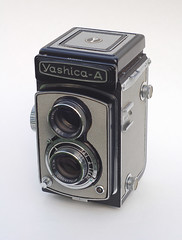Yashica 6×6 TLR (knob advance)
The first camera of the Yashima company (predecessor of Yashica), was the 1953 Pigeonflex, a 6×6 TLR sold by Endō under the Pigeon brand. The company soon decided to make cameras under its own name and released the Yashima Flex, quickly renamed Yashicaflex, in the same year 1953. It would be the first of a long line of 6×6 TLR cameras, comprising many models which were the result of a gradual evolution rather than radical change, and sometimes differ by minor points only; they are conveniently divided into knob advance models and crank advance models.
The knob-wind models were the original Yashica models and as time went on this series retained many of the features of the first models, becoming the Yashica budget line, while the Yashica-mat series gained new features from German high-end cameras and became the professional line. However there are a handful of knob-wind models that have a more intermediate place in the final lineup: the D and 635 have more advanced shutters and controls, while some other models have meters and more basic shutters. There is also a TLR in this series with very basic fixed-shutter speed autoexposure and a built-in flashbulb holder, surely one of a rarified group of AE TLR’s despite its limited usability.
Most knob-wind models, however, have basic shutters topping out at 1/300s, with or without slow speeds, no thumbwheels, no meter, and fairly basic Tessar lenses. While the Yashica-D and 635 are comparable to some of the Rolleicord models, on average the knob-wind Yashica are as basic as TLR’s come except for geared-lens models from manufacturers like Ricoh and Argus. All, to be sure, have front-standard focusing operated by a wheel on the side of the body.
Contents
Yashima Flex
Yashima Flex or Yashimaflex? A few early Yashima Flexes bear a "YASHIMAFLEX" nameplate, but far most of the production got the two-word Yashima Flex name plate, the name under which the camera finally was marketed. Thus it's useful to use the latter name for the camera type, as well as Yashica Flex for its successor Yashica Flex B which bears a similar two-word nameplate and is based on the same camera housing, making it looking almost like the Yashima Flex.
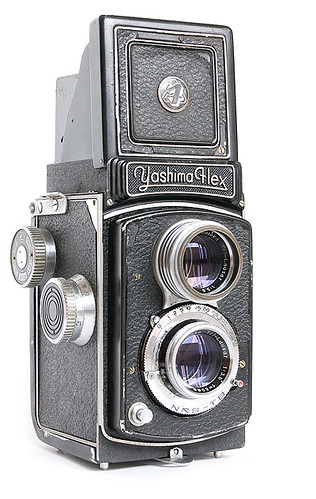
|
| Yashima Flex w NKS-TB shutter - this was almost equal to its successor Yashica Flex B, which got the same Tomioka Tri-Lausar lenses but a faster NKS-FB shutter image by Eugene Ilchenko (Image rights) |
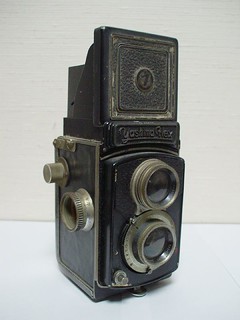
|
| Yashima Flex image by 7 (Nana) (Image rights) |
The Yashima Flex wasn't the first Yashica 6×6 TLR. It was the only TLR badged alike the early company name Yashima. It was already a complete TLR camera. It was closely related to the Pigeonflex, both equipped with NKS shutter and Tomioka Tri-Lausar lenses. The viewfinder hood design has significantly been changed so thereby accommodating a sports finder viewing feature. There seem to be various shutter versions; the NKS or NKS-TB with speeds up to 1/200 and a later NKS-FB version that increase to 1/300.
see also Yashima Flex
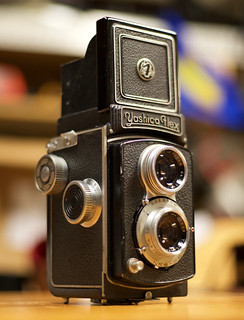
|
| Yashica Flex B (1954-1955), a relative of the Yashima Flex image by Tom Chandler (Image rights) |
Yashica Flex B
The Yashica Flex B is an updated version of the Yashima Flex or simply its rebadged most advanced version with fast shutter, released in approx 1954. This is not to be confused with the later Yashicaflex B or the Yashica-B!
Yashica Flex S ?
The Yashica Flex S has a built-in light meter, and except the two-word name it looks more like later models badged Yashicaflex. And, conflicting with its two-word name-plate, it was marketed as Yashicaflex S! Thus here it's referred to under the name Yashicaflex S.
Yashicaflex
Yashicaflex A
The Yashicaflex model A was released almost the same time as the Yashicaflex B. It is a more basic model that does not have self-timer, and have a maximum shutter speed of 1/200. There seems to be two shutter types available YSK and a Copal version. Uses a red window for film advance counter. Early models tend to have focusing scales in meters and cable release shutter while laters ones are in feet and have a dedicated shutter release button on the body.
Yashicaflex A-II
A similar Yashicaflex A II was also released at about the same time, but with automatic film stop winding and an exposure counter window instead of the red window. Two shutter types were available YSK and Copal. Some models have cable release shutter while others have a dedicated shutter release button on the body.
Yashicaflex B
This has a Copal MXV shutter. It shares the 1/300 of a second NKS-FB shutter as the later revisions of Yashima Flex. Early versions tend to use ASA style flash sync while later one use the German PC type sync connectors.
Yashicaflex C
The Yashicaflex C features Yashikor, Tri-Lausar lenses with a quick Copal based shutter supporting speeds of up to 1/300 of a second a long with a self-timer. It uses a exposure counter above the focus knob. It was most likely targeted as a step below the Yashicaflex S, as it contains similar features but without a exposure meter.

|
| Yashicaflex C image by Jason Hull (Image rights) |
Yashicaflex A-2
The Yashicaflex A-2 uses Citizen MXV shutter with speeds of up to 1/400 of a sec. Film is advance by turning the advance wheel until the next frame number appears in the red window on the back of the camera.
Yashica Rookie
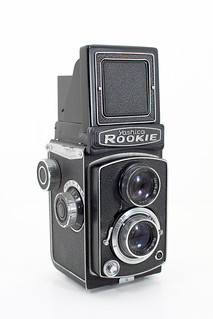
|
| Yashica Rookie image by Jason Hull (Image rights) |
The Yashica Rookie is an amateur budget model TLR camera. It seems to be based on a updated Yashicaflex A, but with a faster shutter. It uses Yashimar lenses with a Copal shutter with speeds of 1/25 to 1/300 and bulb. It has the ability to capture on both 6x6 as well as 6x4.5. It seems to be only available in Japan. The film compartment uses a mask for 6x4.5 and the back has two window one for each format to view the backing paper exposure markings.
Yashica-A

|
| Yashica-A (early) image by Daniel Wirgård (Image rights) |
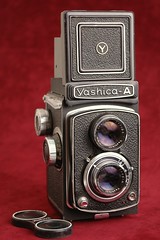
|
| Yashica-A (late) image by digital-analog (Image rights) |
The Yashica-A is an amateur budget model released at the same time as the Yashica-C. It it most likely based on the Japanese market Yashica Rookie as it share many similarities but without the 6x4.5 compatibility. It was released in various colour bodies and leatherettes. Its main features are twin Yashikor 80mm f/3.5 lenses taking bay filters. Yashimar branded lenses are on the earlier models. It uses a Copal shutter, with shutter speeds of 1/25, 1/50, 1/100, and 1/300. It has a PC connection for flash sync, and because it uses a leaf shutter, it is capable of X sync at all shutter speeds. It does not have low shutter speeds or a self-timer.
Operation
Shutter speed is selected by rotating the shutter speed dial. Aperture is set by adjusting a lever on the outside of the shutter speed dial. Film advance is performed by manually turning the advance wheel until the next frame number appears in the red window on the back of the camera.
Yashica-C

|
| Yashica C image by HamWithCam (Image rights) |
The Yashica-C is a more expensive model than the Yashica-A. This added expense allows more control with the Copal-MX shutter. This shutter has more speed settings from 1 to 1/300 of a sec as well as self-timer. The lenses take a bay filter. This model has auto-stop film advance. The original version had a counter that needed to be reset with a button, while later revision models are automatic without the button.
Yashica-B

|
| Yashica B grey Front image by Laclaustra (Image rights) |
The Yashica-B is a basic model variant released just before the 1960's. The camera uses a Copal shutter, but since this is a very basic entry model, shutter speeds are limited with speeds from 1/25 to 1/300 of a sec. (25, 50, 100, 300). The Yashikor lenses do not take bay filters, which were on most of the other cameras in the lineup. At the time of release the Yashica-A was still sold with a similar shutter but the Yashica-B has a film counter window and self-timer that the Yashica-A lack. It is available in both black and grey leatherette.
Yashica-D
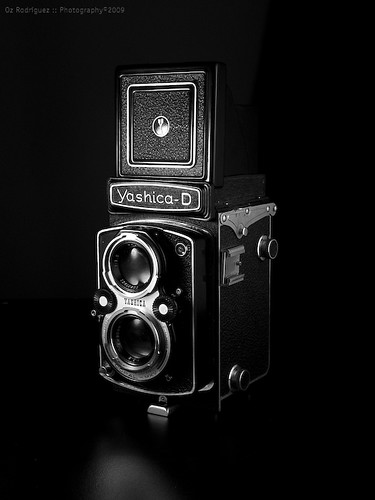
|
| Yashica-D with black knobs image by Oz Rodríguez (Image rights) |
The Yashica-D, sometimes known as the "Yashica-D 66," is, together with its variant the 635, the apex of the knob wind series—while unmetered, it has the best shutter and more convenient controls, making it a fairly modern SLR for its time. It has a Copal-MXV shutter, with shutter speeds of 1 – 1/500th and bulb. It provides a PC connector for flash sync; it is capable of X and M sync at all shutter speeds, and has a self-timer, which can only be used with the camera in X-sync mode (it depends on the same gearing as the M-sync timer.) Early models were equipped with a coated three-element Yashikor 80mm f/3.5 taking lens, while later models had the higher-quality, four-element Yashinon 80mm f/3.5 taking lens. The last Yashica-D models were equipped with bright 80mm f/2.8 Yashinon viewing lenses; models with this viewing lens and the Yashinon taking lens are very desirable on the used market.
Both lenses accept Bay I filters and hoods. A standard cold shoe on the right side is provided, as is standard quarter inch tripod bushing, sports finder, loupe, peg feet for taking exposures from flat surfaces, and lugs for then-common leather straps with buttonholes. In all the camera is provisioned to be an economical working photographer's TLR with no frustrating omissions.
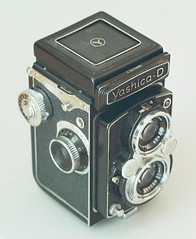
|
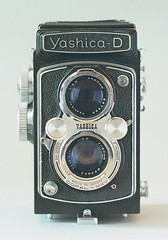
|
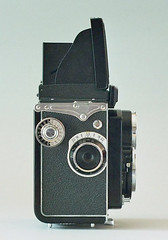
|
|
Yashica D | ||
Operation
Unlike nearly every other knob-wind TLR from Yashica, the D model has Rollei-style thumbwheels for shutter speed and aperture, much as the Yashicamats. These are two small knobs mounted on either side of the "Yashica" badge between the lenses. Holding the camera upright in both hands, the photographer's left thumb falls on the aperture wheel, while the right falls on the shutter-speed wheel. The selected settings are visible on indicator rings seen through a window on top of the viewing lens, so as to be conveniently located when the photographer is viewing the focusing screen. This design puts the Yashica D in line with the very best TLR's... Insofar as the exposure controls are concerned.
There is a notorious failure mode in this design, in that, should the shutter speed ring on the shutter become stiff, this stiffness will be amplified by the gearing, such that it will become increasingly difficult and even impossible to turn the thumbwheel. Forcing it can even cause the gears to jump. A CLA can remedy this if the gears are not stripped.
The focus knob (with DoF scale) is on the right side of the body along with the film advance knob. The advance knob has a film speed reminder dial (which was revised as more speeds of film became common) as well as the advance release button. The shutter has to be cocked by hand after each exposure. The shutter release is on the front in the lower right hand corner. Use of a cable release requires a Leica nipple. After the shutter release has been triggered, advance has to be manually released--there is no double exposure or skipped exposure prevention, as the shutter does not interlock at all. The frame counter is visible on the side of the camera above the film advance knob.
Loading the film is slightly more involved than loading a Yashicamat or late Rolleiflex, as there are no film feelers and the photographer must manually advance the film leader to a certain point, close the back and advance the rest of the way in order to correctly start the exposures at the beginning of the film.
The camera is for 120 only--while it is about the top of the Yashica knob-wind line, it lacks both the 220 capability of some of the Yashicamats, and the 35mm capability of its revised version, the 635 (see below). Use of 220 may throw off the timing of the film advance gears, requiring disassembly to fix-- if the gear catches correctly on film lacking the paper backing.
All this being said it is still sometimes seen with the redlined focusing screen that indicates the area of a 35mm frame in the middle of the area, in portrait orientation when the camera is upright. This is presumably for compositional purposes if the image is to be cropped to 2:3 proportions or made into slides for 35mm slide blanks.
Yashica-635
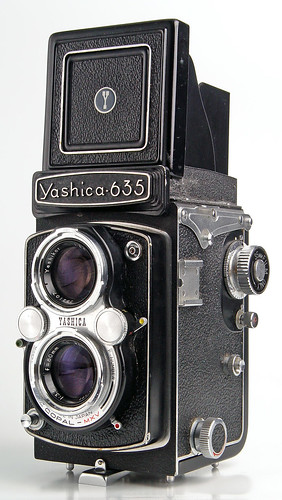
|
| image by Martin Taylor (Image rights) |
The Yashica-635 is basically a D with the added ability to use 35mm film as an alternative to 120. To use 35mm requires an adaptor kit. Novelty aside, the benefit of using 35mm in a 6×6 format TLR is unclear, unless an urge to shoot 35mm Kodachrome was overwhelming. It seems that one gets all the disadvantages of the TLR format (parallax, reversed viewfinder for framing, slow use) without the number-one advantage of the format, the huge film size. Nonetheless some photographers find this feature useful, effectively making two cameras in one--this seems more sensible when one considers the rising price of color film, which to some extent does scale with the size of film. When shooting 120 film, the standard 80mm lends itself well for landscape or architecture but lacks focal length needed for portraits. However, when loaded with 35mm the 80mm lens is ideal for portraits.
The early 635 can be updated from Yashikor to Yashinon lenses by competent repairmen.
Among collectors, the 635 is a little more desirable than the D but the 635 can still be found for less than $100 (sometimes less than $50). At these prices the D and the 635 are good alternatives to the Chinese TLRs still available new today, and adequate substitutes for the much pricier Rolleicord models of similar specifications.
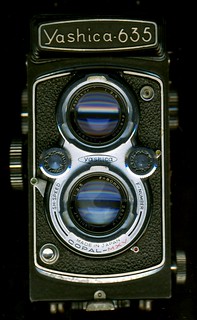
|
| leather insert knobs image by JJ Lee (Image rights) |
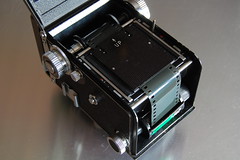
|
| with 135 film loaded image by Raúl Sá Dantas (Image rights) |
Metered Models
Yashicaflex S
The Yashicaflex model S released in the mid-1950's was one of the most advanced TLR produced by the company. They worked with Sekonic to manufacture the selenium exposure meter. The meter is located behind the name plate which has holes to read the light levels. It can also be flipped upward to for measuring low light scale. Both Tri-Lausar and Heliotar lenses are available both using bay filter mounts. Shutter speeds are 1 to 1/300 of a second either using NKS-FB or Copal shutters. It uses a frame counter instead of a red window.

|
| The camera bears name-plate with old-style two-word type-name as meter cover, but look - obviously it was marketed under the one-word type-name Yashicaflex image by yashicasailorboy (Image rights) |
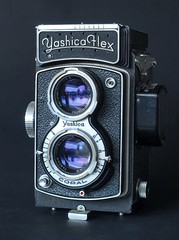 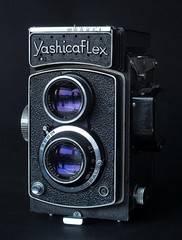 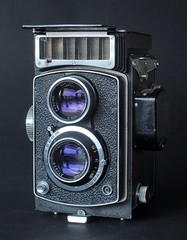
|
| Yashicaflex S, the left with Heliotar lens pair, the right with Yashimar lenses, both with Copal shutter, but different versions with and w/o self timer. images by Simon Spaans (Image rights) |
Yashicaflex AS
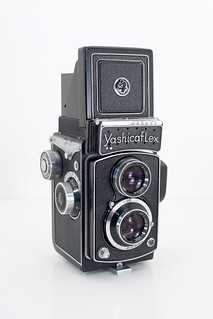
|
| AS-II image by Jason Hull (Image rights) |
The Yashicaflex AS is a metered camera released about the same time as the Yashicaflex S. It was designed as a more basic metered camera compared to the Yashicaflex S with a slower maximum shutter speed of 1/200 and a red window for a frame counter. It is essentially a Yashicaflex A, but with a Sekonic exposure meter.
Yashicaflex AS-II as the name imply is based on the Yashicaflex AII (counter window) but contains a exposure meter. Uses Yashimar lenses with Copal based shutter with 1/10 to 1/200 of a sec. Initial models has the cable release shutters, while later ones have a dedicated button on the body along with PC based flash sync connector.
Yashica LM
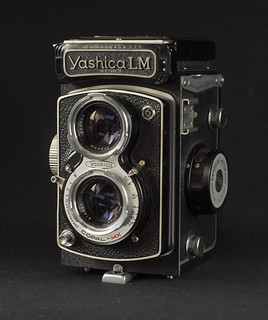
|
| Yashica LM image by Simon Spaans (Image rights) |
The Yashica LM is an advance model with a built-in exposure meter. It was made as a replacement to the older Yashicaflex S. It is similar in design to the Yashica Hi-Mec and was released at about the same time as Yashica-C sharing the same basic attributes but without the meter. It uses a Yashikor 80mm 3,5 lens. The shutter is a Copal-MX with speeds of 1 to 300 of a sec with bulb, in the older style speeds of 1, 2, 5, 10, 25 etc. Early versions had a downward sliding button located between the focus and advance dials to reset the exposure counter while later versions were automatic.
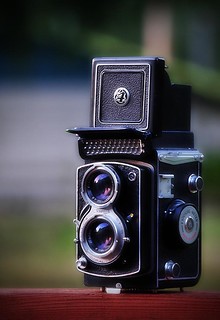
|
| showing meter cells image by Inspiredphotos (Image rights) |

|
| image by Studioesper (Image rights) |
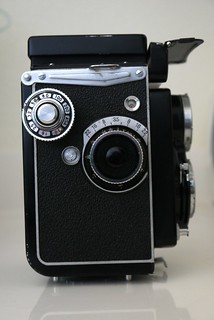
|
| image by Studioesper (Image rights) |
Yashica-E
The Yashica-E was an attempt by Yashica in 1964 to make a TLR as simple to use as a P&S. It has a single shutter speed of 1/60 of a sec. The f-stop automatically set by the built in selenium light meter that surrounds the Yashinon 80mm f/3.5 taking lens. Wind on is semi-automatic and there's even a built in flash that takes peanut flash bulbs hidden behind the E's name plate.
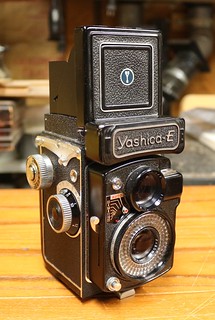
|
| Yashica E image by Tom Chandler (Image rights) |
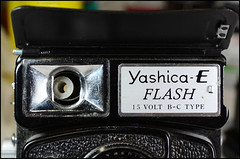
|
| Yashica-E, Flash Unit image by Hans Kerensky (Image rights) |
Links
General links
In English:
- Yashica TLR Cameras
- Yashica-D (Yashikor model) in Matt Denton's camera site
- Yashica TLRs at Barry Toogood's tlr-cameras.com
- Yashica-635 in Alfred's Camera Page
- Yashica-635 by Margaret at kyphoto.com via Internet Archive: The Wayback Machine
- Yashica-635 at the Other Martin Taylor's website
- Yashica 635 at Classic Cameras by RaúlM.
- Yashicaflex at The Camera Site by Reijo Lauro
- Some 100 Yashica PDF Instruction Manuals found at OrphanCameras.com website
In French:
- Yashica TLR overview and Yashica-A at Lionel's 35mm-compact.com
- Yashica A, Yashica B, Yashica D on www.collection-appareils.fr by Sylvain Halgand
In Japanese:
Original documentation
- Yashica leaflet (#72E1) dated 1972, featuring the Yashica-635 and Yashica-D along with crank advance models, at Goodharbor's flickr space
- Manual of the Yashica-635 available at butkus.org
